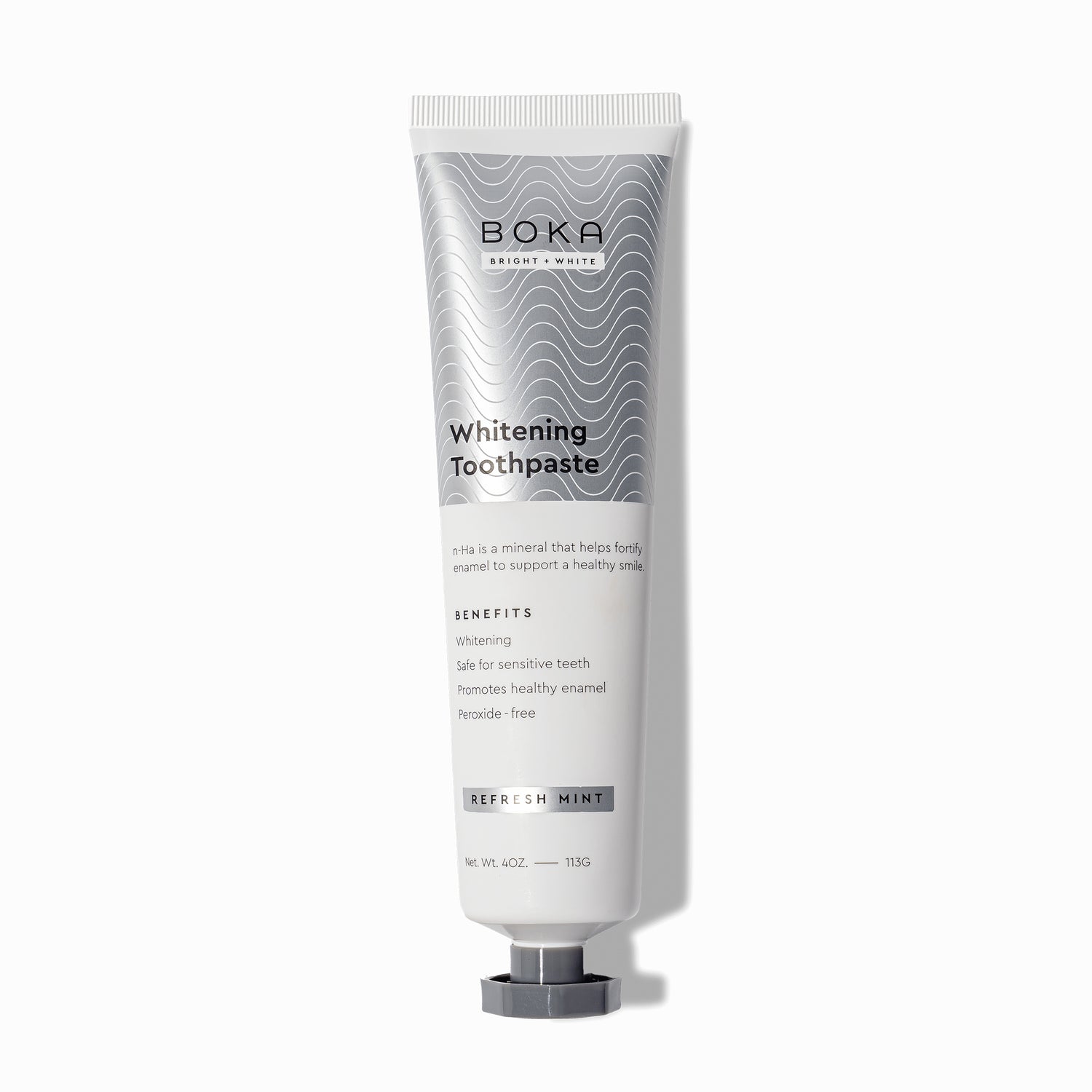Toothpaste: it’s something we all use, but don’t often think about!
However, if there is one thing you likely do know about toothpaste, it’s that it often contains fluoride.
Fluoride has been a contentious topic in recent times. The word is thrown around a lot and has left people wondering what it does and why it is included in our toothpaste formulations.
While fluoride is an effective ingredient in toothpaste, it comes with a host of drawbacks that may outweigh the pros.
These concerns have led to some people turning away from fluoride-containing toothpaste and instead looking for alternatives.
To help you out, we have put together this guide to provide you with all the information you need when it comes to whether fluoride is for you. This guide will cover:
- What fluoride is and how it works
- The pros of fluoride toothpaste
- The cons of fluoride toothpaste
- Alternatives to fluoride toothpaste
- Frequently asked questions.
Let’s get into it!
What Is Fluoride And How Does It Work In Toothpaste?
Fluoride is a naturally occurring mineral found in food, air, seawater, plants, and soil.
It has been shown to prevent tooth decay by allowing the tooth’s enamel to become fortified against the action of acids and other harsh substances that can harm our teeth.
For this reason, it is added to toothpaste as a way to increase the efficiency of the product. In some areas, it is also added to drinking water to provide extra measures against tooth decay and cavities.
Fluoride naturally occurs in very low concentrations. However, when it is added to toothpaste, you receive a very high dosage.
In America, standard family toothpaste contains about 1000 to 1500 parts per million (ppm) of fluoride, and you can find even higher concentrations in different parts of the world.
It is thought that up to 90% of all toothpaste contains fluoride, as it is one of the most effective ways to treat and prevent tooth decay.
Pros Of Fluoride Toothpaste
There is a reason fluoride is so widely used; after all, it has many beneficial elements that can positively impact the health of your teeth.
Most toothpaste companies opt for fluoride as a key ingredient as they know it will deliver results and is also backed by years of research. Here are some of the key pros of fluoride toothpaste:
Strengthens enamel
One of Fluoride’s key functions is to strengthen the enamel of the teeth. This allows for healthier and stronger teeth that are resistant to damage.
Furthermore, strong enamel helps your teeth to stay white and wards off any staining that may occur
Prevents tooth decay
Fluoride is mainly heralded for its ability to prevent tooth decay. Fluoride "remineralizes" tooth enamel by bonding to areas of decay and attracting other minerals, like calcium, to the site of the damage.
It has antimicrobial properties, which kill the bacteria that build up and cause tooth decay. Tooth decay is a serious problem that can negatively impact your teeth; as such, keeping your mouth cavity-free is very important
Promotes remineralization
Sometimes teeth incur wear and tear that aren’t quite cavities but can create the potential for future problems to occur.
Fluoride promotes the remineralization of teeth, which means the defensive forces of the tooth’s surface are rebuilt, making the teeth stronger, whiter, and healthier
Widely available
Fluoride is used in about 90% of all toothpastes. This means it is widely available – and chances are if a store carries toothpaste, at least one of the products (if not all) will contain fluoride!
This accessibility and affordability is a key benefit of using fluoride toothpaste, as you don’t need to worry about not being able to access the product.
Cons Of Fluoride Toothpaste
While fluoride has many pros, it also has its cons.
Depending on your health goals and preferences, the cons of fluoride may not align with what you are looking for – which means you may have to look for an alternative elsewhere.
Risk of fluorosis
Fluorosis is a condition where the teeth have taken in too much fluoride while they are still forming under the gums. Only children under 8 are at risk of this.
Fluorosis causes changes in the tooth enamel and is directly linked to using fluoride toothpaste. Enamel fluorosis refers to fluoride-related alterations in enamel that occur during enamel development. These alterations become more severe with increasing fluoride intake and time of exposure.
Allergy (rare)
While rare, some people do have an allergy to fluoride toothpaste. This can cause fluoride allergy symptoms, adverse skin reactions such as perioral dermatitis (rash around the mouth), stomatitis (sore or inflammation in the mouth), and urticaria (hives) are most commonly observed, as well as anaphylactic shock in severe cases
Environmental impact
Studies have shown that the accumulation of fluoride on plants and animals can have a negative environmental impact.
The presence of fluoride in the water from the use of toothpaste (as well as added fluoride) can pose an environmental risk that you may want to consider.
Taste issues
Fluoride toothpaste can sometimes have a bitter or unsavory taste. This can make brushing your teeth unpleasant, and may even deter some from brushing their teeth at all!

Alternatives To Fluoride Toothpaste
If the cons of fluoride toothpaste worry you, don’t panic!
While most toothpaste does contain fluoride, there are alternatives to fluoride toothpaste out there.
Many of them are just as (if not more) effective and offer a fantastic solution that will allow you to feel confident about your choice of toothpaste.
Here are some of the best alternatives to fluoride toothpaste we think you should try:
Nano-hydroxyapatite (n-Ha) Toothpaste
One of the best alternatives to fluoride toothpaste is nano-hydroxyapatite (n-Ha) toothpaste.
n-Ha is a synthetic form of Hydroxyapatite, another ingredient commonly used in dental care.
It works to remineralize teeth, smoothen enamel, and create a brighter, whiter smile.
n-Ha operates in a very similar way compared to fluoride but doesn’t come with the same concerns and drawbacks, making it arguably the better choice out of the two options.
Here’s a more detailed outline of n-Ha compared to fluoride toothpaste:

This toothpaste from Boka has harnessed the incredible properties of n-Ha to create a fluoride-free toothpaste that is an excellent alternative to other products!
It fortifies and whitens the surface of the teeth, promotes enamel health and strength, and freshens your breath – all without using any fluoride.
Plus, dentists love Boka n-Ha toothpaste; Dr Mark Burhenne says he now “recommends toothpaste containing nano-hydroxyapatite particles. They outperform fluoride when compared side by side, and the best part is that they’re completely non-toxic. My preferred nano-hydroxyapatite toothpaste is Boka’s Ela Mint Toothpaste."
Baking soda toothpaste
Baking Soda toothpaste is another alternative to fluoride-containing toothpaste.
Baking soda has an intrinsic low-abrasive nature because of its comparatively lower hardness in relation to enamel and dentin. Baking soda toothpastes also may contain other ingredients, which can increase their stain removal effectiveness and, consequently, abrasivity. Baking soda is widely known for its stain-removing properties, which means it can whiten your teeth and leave you with a clean smile.
It also neutralizes the acids that can cause plaque buildup, ensuring your teeth stay clean and your breath is fresh.
Charcoal Toothpaste
There has been some evidence that charcoal is a great way to whiten teeth and remove surface stains.
Some even say that the Romans brushed their teeth with charcoal! You can now buy charcoal toothpaste quite readily, so it is another alternative to fluoride toothpaste that doesn’t provide the same issues and concerns.
Herbal toothpaste
Herbal toothpaste usually contains natural ingredients such as clove oil, aloe vera, calendula, and papaya leaf extract.
These types of toothpaste are generally fluoride-free, as the focus is on providing a natural and plant-based solution to dental care.
Research has shown that herbal toothpaste is great for reducing plaque buildup, which makes it a good choice if you’re looking to ditch the fluoride toothpaste and try an alternative product.
FAQs
Is fluoride toothpaste safe?
Yes, fluoride toothpaste is generally safe for everyone to use. The concentration of the mineral in toothpaste is too low to be toxic to humans and is regulated at a safe amount.
However, there are some concerns for a small group of people, including those at risk for fluorosis and those who might be allergic to fluoride.
Is it bad to use fluoride toothpaste every day?
It is not bad to use fluoride toothpaste every day. Fluoride can be great for preventing cavities and promoting a healthy mouth.
You should be using some kind of toothpaste every day to ensure optimal mouth health, and it is fine to use fluoride toothpaste if that is your preferred product.
What is wrong with fluoride in toothpaste?
The inclusion of fluoride in toothpaste brings up several concerns. These are the risk of fluorosis in young children, the environmental impact it may have, as well as the potential for a small group of the population to be highly allergic.
If any of these factors concern you, you should consider switching to a fluoride-free toothpaste.
Does fluoride make teeth yellow?
If you have excessive fluoride and have developed fluorosis, your teeth may develop a slight yellowish hue.
Otherwise, fluoride does not make your teeth yellow. It promotes strong enamel and a clean mouth, which in turn can make your teeth whiter.
Related Reads:
- Is Nano-Hydroxyapatite Better Than Fluoride?
- Why Avoid Fluoride in Toothpaste?
- What To Look For In Toothpaste?
- Is Nano-Hydroxyapatite Better Than Fluoride? (Comparison)
- Does Fluoride-Free Toothpaste Work?
- Do Adults Need Fluoride Toothpaste?
- Hydroxyapatite vs Nano-Hydroxyapatite: Which is Right for You?


